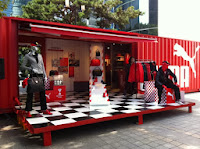I have been writing about the disruption in the way people shop for some time now. Technology like Google Glass, HoloLens, 3D Printing, etc., is going to disrupt the retail environment as much as the internet did or maybe more so. It is only a matter of time before such devices become mainstream because of their price becoming affordable as also supporting software being available. Slowly but surely these changes are entering into the retail environment.
One of the key shopper expectations is to be able to purchase products which are different, unique and customized. Such purchases used to be quite expensive but no longer. Shoppers can now purchase 3D printed and customized products online from sites such as Shapeways, i.materialise, thingify, etc. Amazon has taken this to the next level and plans include a patented 3D printing truck which would come to your doorstep and print out the product! When 3D printers become affordable and mainstream, you could do the same at home, without even having to wait for that truck.
Alternatively you could drop into a store and get things made for you in a short while. This could be anything including a book being printed and bound in front of your eyes. This is what “Librairie des Puf”, a book store run by the publisher University Press of France does. They use an Espresso Book Machine which makes a book right in front of your eyes.
This machine used to be quite expensive but the prices have dropped over the years. Many smaller stores tried adopting a similar model but ran into issues when the publishers were not ready to share the content for instant printing of the books. Although eBooks are gaining ground, there are a significant number of readers who still prefer a hard copy one to read. With real estate costs rising and the overall spends on physical books becoming very niche, this trend of buying instantly printed books might be the future for the purchase of books.
As a shopper if you like online, the next level would be the virtual world and retail might cater to that preference too. Shopping in a holographic, 3D virtual store might take a bit longer but a step closer to this is what eBay is trying out in Australia. In association with Myers, a leading department store chain they are bring Virtual Reality stores to the shoppers, wherever they might be in the country.
This video would give you an idea of how the Virtual Reality shopping will be done in what is positioned as the world’s first Virtual Reality Department store.
An earlier post had detailed about how shopping might evolve in the coming years. The pace at which technology is evolving shows that the future is far closer than what was thought. Physical shopping, Online, Omni channel and it seems like it virtual reality shopping will soon encompass all these while redefining the retail space, business models, etc.
Are you ready to change the way you shop!


























